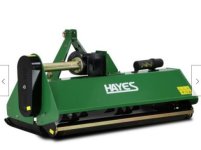Incorrect.
When the tractor rear comes off the ground, the front axle is the fulcrum and both rear wheel weights and loaded tires provide some counterbalance.
However, the same rear wheel weight and/or loaded rear tire weight on the Three Point Hitch is much more effective due to leverage of weight positioned further to the rear.
The wheel weights and loaded tires do nothing to transfer the weight of the load from the front axle. The front axle remains the fulcrum. This results in the wear and tear of the front axle. It also stress the front tires which results in the tire coming off the rim due to an overload.
Ballast on the rear of the tractor will make the rear axle act as the fulcrum. At this point the larger stronger non-steering axle can hold the weight. The steer axle will now be lighter thus reducing wear and tear as well as reducing the possibility of damage to overloaded front tires.
The weight added to the rear axle allows the tractor to pick up more of a load. However it does not allow the stress of the load to be transferred from the front axle to the rear axle.
A semi truck is setting on a scale and the front axle is to heavy. You can add all the weight you want to the rear axle and the front axle will remain to heavy. Move the 5th wheel behind the rear axle, making the rear axle the fulcrum, and the weight will lighten on the front axle.

